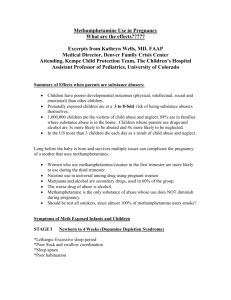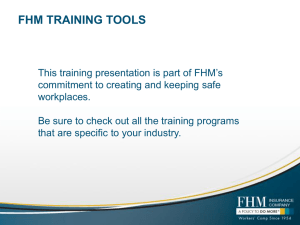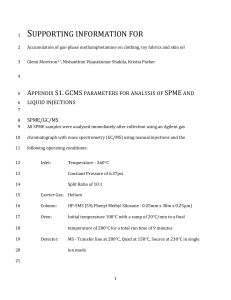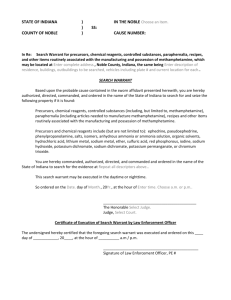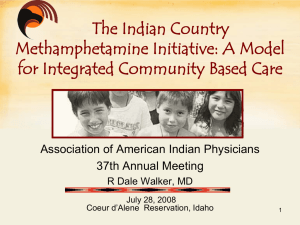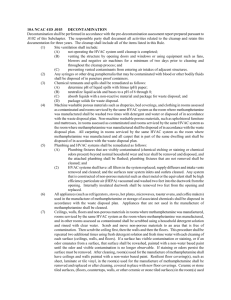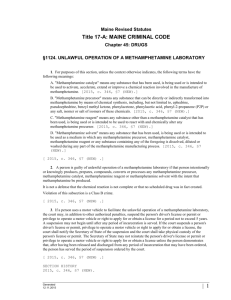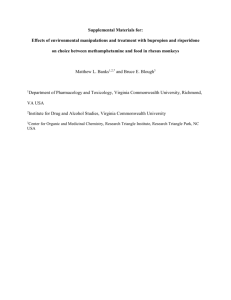Open poster - CTN Dissemination Library
advertisement
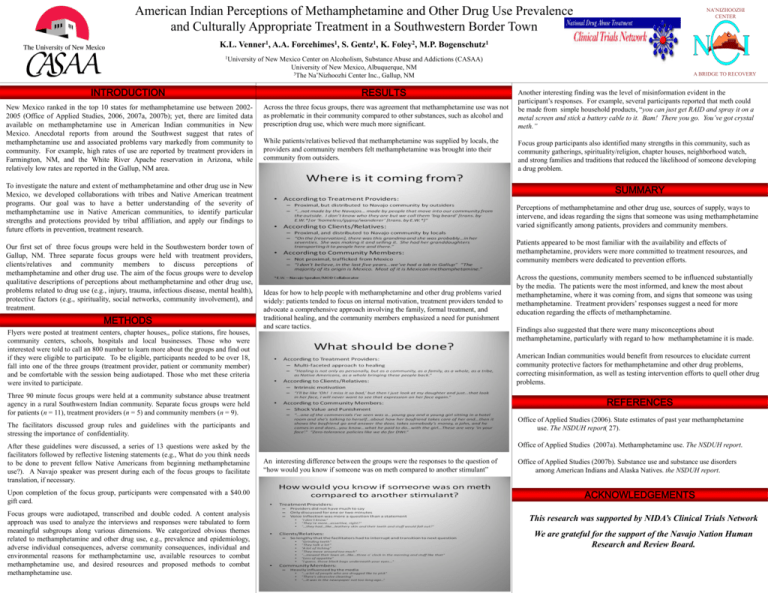
American Indian Perceptions of Methamphetamine and Other Drug Use Prevalence and Culturally Appropriate Treatment in a Southwestern Border Town NA’NIZHOOZHI CENTER K.L. Venner1, A.A. Forcehimes1, S. Gentz1, K. Foley2, M.P. Bogenschutz1 1University INTRODUCTION New Mexico ranked in the top 10 states for methamphetamine use between 20022005 (Office of Applied Studies, 2006, 2007a, 2007b); yet, there are limited data available on methamphetamine use in American Indian communities in New Mexico. Anecdotal reports from around the Southwest suggest that rates of methamphetamine use and associated problems vary markedly from community to community. For example, high rates of use are reported by treatment providers in Farmington, NM, and the White River Apache reservation in Arizona, while relatively low rates are reported in the Gallup, NM area. of New Mexico Center on Alcoholism, Substance Abuse and Addictions (CASAA) University of New Mexico, Albuquerque, NM 3The Na’Nizhoozhi Center Inc., Gallup, NM RESULTS Across the three focus groups, there was agreement that methamphetamine use was not as problematic in their community compared to other substances, such as alcohol and prescription drug use, which were much more significant. While patients/relatives believed that methamphetamine was supplied by locals, the providers and community members felt methamphetamine was brought into their community from outsiders. METHODS Flyers were posted at treatment centers, chapter houses,, police stations, fire houses, community centers, schools, hospitals and local businesses. Those who were interested were told to call an 800 number to learn more about the groups and find out if they were eligible to participate. To be eligible, participants needed to be over 18, fall into one of the three groups (treatment provider, patient or community member) and be comfortable with the session being audiotaped. Those who met these criteria were invited to participate. Patients appeared to be most familiar with the availability and effects of methamphetamine, providers were more committed to treatment resources, and community members were dedicated to prevention efforts. Ideas for how to help people with methamphetamine and other drug problems varied widely: patients tended to focus on internal motivation, treatment providers tended to advocate a comprehensive approach involving the family, formal treatment, and traditional healing, and the community members emphasized a need for punishment and scare tactics. Focus groups were audiotaped, transcribed and double coded. A content analysis approach was used to analyze the interviews and responses were tabulated to form meaningful subgroups along various dimensions. We categorized obvious themes related to methamphetamine and other drug use, e.g., prevalence and epidemiology, adverse individual consequences, adverse community consequences, individual and environmental reasons for methamphetamine use, available resources to combat methamphetamine use, and desired resources and proposed methods to combat methamphetamine use. Across the questions, community members seemed to be influenced substantially by the media. The patients were the most informed, and knew the most about methamphetamine, where it was coming from, and signs that someone was using methamphetamine. Treatment providers’ responses suggest a need for more education regarding the effects of methamphetamine. Findings also suggested that there were many misconceptions about methamphetamine, particularly with regard to how methamphetamine it is made. American Indian communities would benefit from resources to elucidate current community protective factors for methamphetamine and other drug problems, correcting misinformation, as well as testing intervention efforts to quell other drug problems. REFERENCES Office of Applied Studies (2006). State estimates of past year methamphetamine use. The NSDUH report( 27). The facilitators discussed group rules and guidelines with the participants and stressing the importance of confidentiality. Upon completion of the focus group, participants were compensated with a $40.00 gift card. Focus group participants also identified many strengths in this community, such as community gatherings, spirituality/religion, chapter houses, neighborhood watch, and strong families and traditions that reduced the likelihood of someone developing a drug problem. Perceptions of methamphetamine and other drug use, sources of supply, ways to intervene, and ideas regarding the signs that someone was using methamphetamine varied significantly among patients, providers and community members. Three 90 minute focus groups were held at a community substance abuse treatment agency in a rural Southwestern Indian community. Separate focus groups were held for patients (n = 11), treatment providers (n = 5) and community members (n = 9). After these guidelines were discussed, a series of 13 questions were asked by the facilitators followed by reflective listening statements (e.g., What do you think needs to be done to prevent fellow Native Americans from beginning methamphetamine use?). A Navajo speaker was present during each of the focus groups to facilitate translation, if necessary. Another interesting finding was the level of misinformation evident in the participant’s responses. For example, several participants reported that meth could be made from simple household products, “you can just get RAID and spray it on a metal screen and stick a battery cable to it. Bam! There you go. You’ve got crystal meth.” SUMMARY To investigate the nature and extent of methamphetamine and other drug use in New Mexico, we developed collaborations with tribes and Native American treatment programs. Our goal was to have a better understanding of the severity of methamphetamine use in Native American communities, to identify particular strengths and protections provided by tribal affiliation, and apply our findings to future efforts in prevention, treatment research. Our first set of three focus groups were held in the Southwestern border town of Gallup, NM. Three separate focus groups were held with treatment providers, clients/relatives and community members to discuss perceptions of methamphetamine and other drug use. The aim of the focus groups were to develop qualitative descriptions of perceptions about methamphetamine and other drug use, problems related to drug use (e.g., injury, trauma, infectious disease, mental health), protective factors (e.g., spirituality, social networks, community involvement), and treatment. A BRIDGE TO RECOVERY Office of Applied Studies (2007a). Methamphetamine use. The NSDUH report. An interesting difference between the groups were the responses to the question of “how would you know if someone was on meth compared to another stimulant” Office of Applied Studies (2007b). Substance use and substance use disorders among American Indians and Alaska Natives. the NSDUH report. ACKNOWLEDGEMENTS This research was supported by NIDA’s Clinical Trials Network We are grateful for the support of the Navajo Nation Human Research and Review Board.
